We begin by visiting the lovely village of San Gimignano, where these crocusses could make the argument that it`s spring all year round. There was an exquisite Sunday morning Crafters market`, and a hat shop, and too many other places for us to browse for me to remember them all. But I did find one quite interesting establishment that I've put on my Must See list for my next visit.
I don't think that you need to speak much Italian to get the gist of what this museum offers.
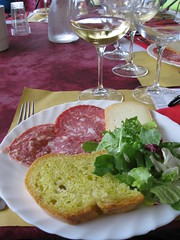
A bit of a bus ride and we arrive at Tenuta Trociano, the winery where we will be having lunch.
You will notice that this gorgeous appetizer plate is set down in front of a set of wine glasses. After a lesson in how to swirl the wine properly to smell its bouquet most effectively, we tried 7 different wines. We were advised that if we didn't want to finish all 4 oz that were poured of each of the wines that we could pour the unwanted portion into a jar on the table placed there for that purpose. It was enough to make us weep, the thought of `wasting` all of that magnificent wine, but really, it was only 1 o`clock in the afternoon.
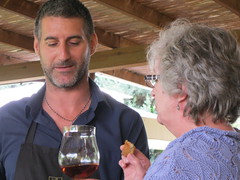 Here at the right, we see Lorna, of our group, receiving instructions on dipping the cantucino, or small biscotti into the dessert wine. It was my opinion that all the bakers in Italy could just retire as there was no need for any other sweet beyond this pairing.
Here at the right, we see Lorna, of our group, receiving instructions on dipping the cantucino, or small biscotti into the dessert wine. It was my opinion that all the bakers in Italy could just retire as there was no need for any other sweet beyond this pairing.Things I learned about the wines of the region:
-Super Tuscan is made of a blend of 5 red grapes and is aged for 5 years in the barrel before being bottled.
-1997 was the best year in recent history for Italian wine quality, and 2002 was the worst.
-The best Sauvignon Blanc comes from New Zealand.
-San Giovese from the Chianti region of Tuscany is the best red wine in Italy.
So some of us ordered our wine to be shipped home, and others opted to bring their vino and bottles of the most perfect olive oil and-or 30 year old balsamic vinegar that was as thick as molasses along with them on the bus.
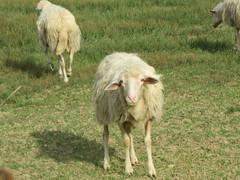 We slept most of the way to our next destination of Fattoria Pianporcino in Pienza, to a family run farm that has been making Pecorino cheese for generations. I am not a cheese connoisseur but I was a little embarassed that, as a friend of sheep and most of their by-products, I didn`t realize that pecorino is a cheese made from sheep`s milk.
We slept most of the way to our next destination of Fattoria Pianporcino in Pienza, to a family run farm that has been making Pecorino cheese for generations. I am not a cheese connoisseur but I was a little embarassed that, as a friend of sheep and most of their by-products, I didn`t realize that pecorino is a cheese made from sheep`s milk. This is what the Sardinian sheep look like. Nothing particularly noteworthy in their appearance, BUT they are to the pecorino world what Jersey cows are in their own field of milk production. Bountiful!
Another lesson in the fine points of agricultural food production in Tuscany and we learn that the cheeses are aged by allowing the mould to grow around the cakes and they are layered between an assortment of different materials to give them distinctive flavours.
The one on the far left is the youngest of these cheeses, having been rubbed with tomato paste. The others are several weeks older and have been layered between bay leaves and grape leaves respectively. Needless to say, we are spoiled once again with a delightful selection of breads, wines and cheeses of different ages and textures, including the ricotta cheese that is traditionally eaten spread on a piece of excellent Italian bread and sprinkled with sugar.
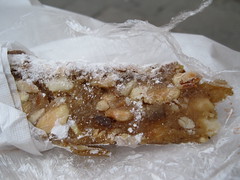 We then returned to a bit of an afternoon shopping spree to the town of Pienza where many of us chose to hang out at a cafe and drink espresso, eat Panne Forte (pictured here, it`s a rich cake of energy bar consistency made of honey, dried fruit and nuts, and sold by the slice), and stroll along the walkway behind the town`s church that had the most wonderful vistas that we saw in the whole trip.
We then returned to a bit of an afternoon shopping spree to the town of Pienza where many of us chose to hang out at a cafe and drink espresso, eat Panne Forte (pictured here, it`s a rich cake of energy bar consistency made of honey, dried fruit and nuts, and sold by the slice), and stroll along the walkway behind the town`s church that had the most wonderful vistas that we saw in the whole trip. Needless to say, we didn`t spend too much time socializing back at the Villa when we returned that night! We were all very tired little teddy bears - to quote one of my favourite songs.

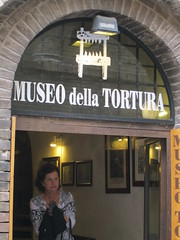



No comments:
Post a Comment